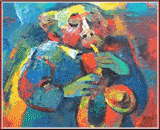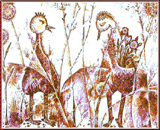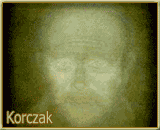|
For participation in the project as the
seller it is necessary to fill the questionnaire
Natalia Kochubeevskaya
About artist Veniamin Kletzel
(Clause from an album "Veniamin Kletsel" Verba Publishers
Ltd. Jerusalem 2005)
The catalogue of pictures of Veniamin Kletzel
The picture story about opening an exhibition of Veniamin Kletzel
 |
GENEROUS GIFT
Congratulations - you became a lucky owner of Benjamin Kletzel's album. I
am happy for those who have already seen his works umpteen times, and envy
those who are going to see them for the first time. His works are bright,
full of significance, joy and sorrow, love and philosophy, irony and pity,
sometimes paradoxical, but always tinged with delight; and the source of
this delight is the life in all its diversity.
Here is how an artist differs from a layman: his eyes can see things
invisible to others, his hand can depict the world on the canvas, and his
heart responds to joys and sorrows of this world. The color of Kletzel's
eyes is that of a sea near Eilat, his look is penetrating and keen, his
hands are strong and muscular, like artisan's, his heart is brimful of
love to people and admiration for our complicated and contradictory world.
"Self portrait" of 1998 (plate 1) looks at us... well, not severely, but
very gravely and closely; this look penetrates into the depth of the soul,
into the heart of the matter. And not without reason he clenches the
brushes as hard as a weapon, since the world around us is so fierce, so
brave and stunning! The artist is longing to perceive, to grasp the whole
lot, and then to reveal his attitude, which he assumed to express his
feelings. The magnificently modeled face, the psychological depth, and
even the background of this picture - everything compels the spectator to
enjoy not only the masterly strokes, but also the artist's narrative on
the whole.
Artist's outlook was forming gradually. His childhood in a small town of
Pervomaysk (Ukraine): "Looking back" (plate 26) - a primus-stove, a
lantern, a pan with fried fish, whitewashed small houses - things, which
are long-forgotten and still dear to one's heart; "Shtetl artist" (plate
33), a wise and gloomy man, "not of this world". Then the Kletzels were
evacuated to Tashkent. |
|
 Says
Benjamin Kletzel, "I am grateful to people, who sheltered us. I distinctly
remember Tashkent of those days. Despite harsh war years, it was a feeling
of a holyday, with donkeys and camels in city streets; women wearing
yashmaks, clay fences, aroma of pilaf- everything created a specific local
atmosphere." Since then oriental themes, scorching sun, intense colors
became an inalienable part of Kletzel's palette. Says
Benjamin Kletzel, "I am grateful to people, who sheltered us. I distinctly
remember Tashkent of those days. Despite harsh war years, it was a feeling
of a holyday, with donkeys and camels in city streets; women wearing
yashmaks, clay fences, aroma of pilaf- everything created a specific local
atmosphere." Since then oriental themes, scorching sun, intense colors
became an inalienable part of Kletzel's palette.
Kletzel began painting in his teens. First it was the art studio at
Tashkent Palace of Pioneers, then he studied at Art college and after that
graduated from Art Department of Tashkent Theater and Art Institute. Among
his teachers was a prominent artist Alexander Volkov (famous for his
"Pomegranate chaikhana"). Kletzel heartily and gladly speaks about his
friends, Tashkent artists of those days - Yuri Taldykin, Vladimir
Burmakin, Evgeny Melnikov, Ruzy Charyev and Garik Zilberman, who now also
lives in Jerusalem.
Kletzel did not cease painting during his four-year conscription period,
and his works were presented at several exhibitions. Then he moved to
Samara (former Kuybyshev); there he lived for many years, gave classes at
Art School and, as an assistant professor of Civil Engineering Institute,
taught architectural students at the Chair of Drawing.
Benjamin Kletzel held several honorable titles and academic ranks (among
them Member of the USSR Artists' Union, assistant professor of Samara
Institute of Civil Engineering), he took part in a great many of art
exhibitions... But he considers the title of a "Jerusalem artist" as the
most significant, since his major pictures were painted after his
immigration to Israel in 1990. Here he found his "ego", his subjects and
his characters.
He was astonished by a torrent of impressions: ancient stones of
Jerusalem, olive groves, narrow streets, unfathomable blue sky, blazing
sun, and Jews, bearded and eternal, like their Eternal City. Kletzel found
his own Jerusalem; it was a city of his sole vision, painted with his
inimitable colors.
"Fright" (plate 8) was painted after a suicide bombing in Jerusalem.
Kletzel depicts neither the explosion of Bus 18, nor its blood-spattered
victims. The picture is an allegory of Horror: a dog howling over the
city, against the background of the crimson sky.
The artist says that often a picture is born basing on a hint, an
impression, which flashed through his mind. Kletzel never paints "from
life"; he does not copy the reality, but reconsiders it, thus creating an
artistic image.
Once, on Simchat Torah holiday, he saw religious Jews dancing with Torah
scrolls near the Wailing Wall. It
 inspired
him to paint one of his most wonderful pictures - "Simchat Torah" (plate
17): a group of Jews, hand in hand, dancing in a round. Their unity is
emphasized with subdued colors. The artist does not strive to
individualize his characters; they rather look alike, since the key point
of the picture is to demonstrate their common mental and emotional state. inspired
him to paint one of his most wonderful pictures - "Simchat Torah" (plate
17): a group of Jews, hand in hand, dancing in a round. Their unity is
emphasized with subdued colors. The artist does not strive to
individualize his characters; they rather look alike, since the key point
of the picture is to demonstrate their common mental and emotional state.
Kletzel studies diligently the heritage of his favorite artists; among his
much loved are Marc Chagall, Pablo Picasso, Chaim Sutin (Sutin's portrait
is included into this album - plate 36). It is not easy to assign Kletzel
to a certain art trend. Sometimes he is fauvist, with his abundant colors
and brimming vividness, and sometimes minimalist, when he expresses a
great deal, using so few artistic means.
Let us take one of his best works "Le'chaim!" (plate 22): nosey Jews with
bulging eyes are sitting around the table. Sidur, shofar, a seven-branched
candelabrum, five glasses of wine, a forsaken fish on a plate in front of
them, and a pale crescent above them. That's all. Where are these
look-ing-alike people, these brothers united with one destiny, one mood,
one melody - are they on the earth or in the sky?
Figures of "Purim" (plate 37) seem to be woven from blue moonlight; the
subdued, almost mono-chromic palette and the precise composition add
exclusive charm to this picture. Kletzel`s works are abounding with
matchless personages: Jews carrying plump chickens and huge fishes,
vociferous roosters, "watermelon eaters"... For hours and hours one can
enjoy these pictures, so diverse and so unique. But in all this diversity
one can indisputably perceive Kletzel's manner, his position, his outlook.
Self portraits are a special category of his artwork. Kletzel is far from
flattering himself; he never misses a chance to look at himself, or at
life, with a wry smile.
His "Shaving man" (plate 21) is tragic and unforgettable. It is an ideal
example of grotesque, with a good deal of expressiveness and eloquence.
Quite different is "Slava's portrait" (plate
24). Benjamin Kletzel's wife Slava Bondarenko was a prima donna of Samara
Opera Theater, the Honored Artist of Russian Federation. She is the
artist's faithful lifelong friend, the source of inspiration, support and
encouragement in all his endeavors. Kletzel puts all his love and
tenderness into this portrait, each stroke breathes with his affection.
As a portraitist, Kletzel demonstrates deep psychological insight. Usually
he paints people, whom he finds spiritually congenial. Such are the
portraits of artist Leon Meyer (plate 7), or poet Igor Guberman (plate 9).
Benjamin Kletzel is a high-class professional. Though he claims that
"school and manner should not be too obvious" in a picture, his
professional manner is always vivid and easy-to-read. Kletzel continually
makes sketches; there are above 2,500 sketches in his working albums.
Kletzel is a multifarious and versatile artist. He does not confine
himself to painting and graphic works, but also succeeded as a stage
designer and a book illustrator. Several books were published with his
illustrations - mostly books written by his new Israeli friends.
Kletzel is happy and proud of his comradeship with people of arts.
 He
says, "Writers, poets, artists came to Israel from various places of the
Former Soviet Union. They all contribute to the culture and art life of
their historical Motherland. I am lucky that we are on friendly terms with
an excellent writer Gregory Kanovich. He familiarized me with the life of
shtetl Jews, and it helped me to illustrate his books. There are many
talented artists in Jerusalem, and it was a real pleasure to participate
in group exhibitions with them." He
says, "Writers, poets, artists came to Israel from various places of the
Former Soviet Union. They all contribute to the culture and art life of
their historical Motherland. I am lucky that we are on friendly terms with
an excellent writer Gregory Kanovich. He familiarized me with the life of
shtetl Jews, and it helped me to illustrate his books. There are many
talented artists in Jerusalem, and it was a real pleasure to participate
in group exhibitions with them."
During 15 years of Israeli life Benjamin Kletzel had nine solo exhibitions
in Jerusalem, one in Tel Aviv, two in Russia and one in the USA. His works
can be found in museums, galleries, and private collections in Bulgaria,
France, Germany, Hungary, Israel, Russia, South Africa, and the USA.
Kletzel's studio is in Jerusalem downtown, in Jaffa Street. The place
smells nicely of paint and turpentine; a lot of pictures are on the walls
and shelves. It is a vociferous world: Chasids are praying and singing,
roosters are crowing, donkeys are braying, dogs are howling... Each human
being, each animal, landscape, still life - everything is painted in
Kletzel's unique manner: a blend of wisdom and childlike simplicity.
Benjamin Kletzel works in his studio every day, and every day he makes
discoveries. He creates new pictures and reveals the secrets of true art
to all of us.
Natalia Kochubeevskaya,
art critic and friend
|
|
EXHIBITIONS
1968 - Solo Exhibition. Museum of Fine Arts, Samara, USSR.
1975 - Group Exhibition. 30th Anniversary of WW II. All-Union Exhibition.
Municipal Museum,
Volgograd, USSR.
1976 - Group Exhibition. The Greater Volga Regional Exhibition. Museum of
Fine Arts, Gorky,
USSR.
1976 - Group Exhibition. Art Museum, Stara Zagora, Bulgaria.
1982 - Solo Exhibition. Artist's 50th Jubilee. Museum of Fine Arts,
Samara, USSR.
1993 - Solo Exhibition. Immigrant's Communities House, Jerusalem, Israel.
1994 - Solo Exhibition. Rehavia Community Center, Jerusalem, Israel.
1995 - Solo Exhibition. Jewish Community Center, Chicago, USA.
1996 - Solo Exhibition. Aviv Gallery, Tel Aviv, Israel.
1997 - Group Exhibition of Jerusalem artists. Immigrant's Cultural Center,
Jerusalem, Israel.
1998 - Solo Exhibition. Museum of Fine Arts, Samara, USSR.
2000 - Group Exhibition. Binyanei Ha'uma, Jerusalem, Israel.
2001 - Solo Exhibition. Nina Gallery, Jerusalem, Israel.
2001 - Group Exhibition. Teatron Yerushalaim, Jerusalem, Israel.
2002 - Solo Exhibition. Artist's 70th Jubilee. Immigrant's Cultural
Center, Jerusalem, Israel.
2002 - Solo Exhibition. Teena Gallery, Jerusalem, Israel.
2004 - Solo Exhibition. Museum of Fine Arts, Samara, USSR.
2005 - Solo Exhibition. Self Portrait. Teena Gallery, Jerusalem, Israel.
The catalogue of pictures of Veniamin Kletzel
The picture story about opening an exhibition of Veniamin Kletzel
|
For participation in the project as the seller it is
necessary to fill the questionnaire
|

 Says
Benjamin Kletzel, "I am grateful to people, who sheltered us. I distinctly
remember Tashkent of those days. Despite harsh war years, it was a feeling
of a holyday, with donkeys and camels in city streets; women wearing
yashmaks, clay fences, aroma of pilaf- everything created a specific local
atmosphere." Since then oriental themes, scorching sun, intense colors
became an inalienable part of Kletzel's palette.
Says
Benjamin Kletzel, "I am grateful to people, who sheltered us. I distinctly
remember Tashkent of those days. Despite harsh war years, it was a feeling
of a holyday, with donkeys and camels in city streets; women wearing
yashmaks, clay fences, aroma of pilaf- everything created a specific local
atmosphere." Since then oriental themes, scorching sun, intense colors
became an inalienable part of Kletzel's palette. inspired
him to paint one of his most wonderful pictures - "Simchat Torah" (plate
17): a group of Jews, hand in hand, dancing in a round. Their unity is
emphasized with subdued colors. The artist does not strive to
individualize his characters; they rather look alike, since the key point
of the picture is to demonstrate their common mental and emotional state.
inspired
him to paint one of his most wonderful pictures - "Simchat Torah" (plate
17): a group of Jews, hand in hand, dancing in a round. Their unity is
emphasized with subdued colors. The artist does not strive to
individualize his characters; they rather look alike, since the key point
of the picture is to demonstrate their common mental and emotional state. He
says, "Writers, poets, artists came to Israel from various places of the
Former Soviet Union. They all contribute to the culture and art life of
their historical Motherland. I am lucky that we are on friendly terms with
an excellent writer Gregory Kanovich. He familiarized me with the life of
shtetl Jews, and it helped me to illustrate his books. There are many
talented artists in Jerusalem, and it was a real pleasure to participate
in group exhibitions with them."
He
says, "Writers, poets, artists came to Israel from various places of the
Former Soviet Union. They all contribute to the culture and art life of
their historical Motherland. I am lucky that we are on friendly terms with
an excellent writer Gregory Kanovich. He familiarized me with the life of
shtetl Jews, and it helped me to illustrate his books. There are many
talented artists in Jerusalem, and it was a real pleasure to participate
in group exhibitions with them."



